Revolutionise care for people and planet
Transforming care for patients and caregivers
At Mölnlycke, we have always been dedicated to improving quality of life for patients and those who care for them. We do it by offering innovative, high-quality solutions for wound care and surgical procedures, and by helping you implement new, better ways of working. Ultimately, we enable safer, more efficient and more sustainable care. For people and planet.
-
Wound care solutions
Explore our offer of innovative solutions that are optimised for health care workflows while improving quality of care for patients.
Discover our wound care solutions -
Surgical solutions
A safe and stress-free care environment, where clinicians can perform at their very best, doing the job they care most about.
Discover our surgical solutions
We're here to help
If you have any question about our products and solutions or need assistans, contact our sales team. We look forward to helping you find the perfect solution for your needs.
Contact usLatest updates
Discover our latest offers and campaigns.
Let's make room for what matters
There are many examples of non-value added tasks, in or around the OR, that could easily be eliminated, simply by implementing more efficient ways of working.
Read more-
Find the right antiseptic product
Our antiseptic products are gentle on the skin and effective on microbes with long lasting effect. Support skin integrity and reduce the potential of infections.
Read more -
Introducing the new Mepilex Up:
An innovative foam dressing designed for exuding wounds.
Read more
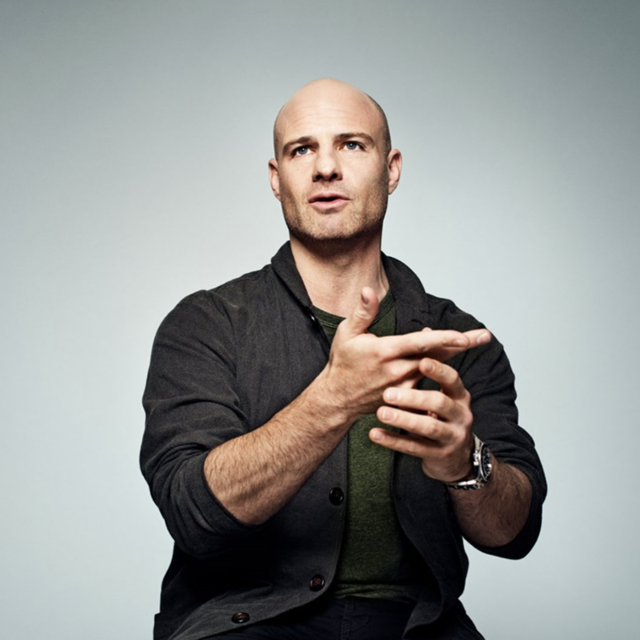
‘I always double-glove, and have from the very beginning. It's never been a challenge to work this way.’
David Revez Neurosurgeon
Latest news
Read all news-
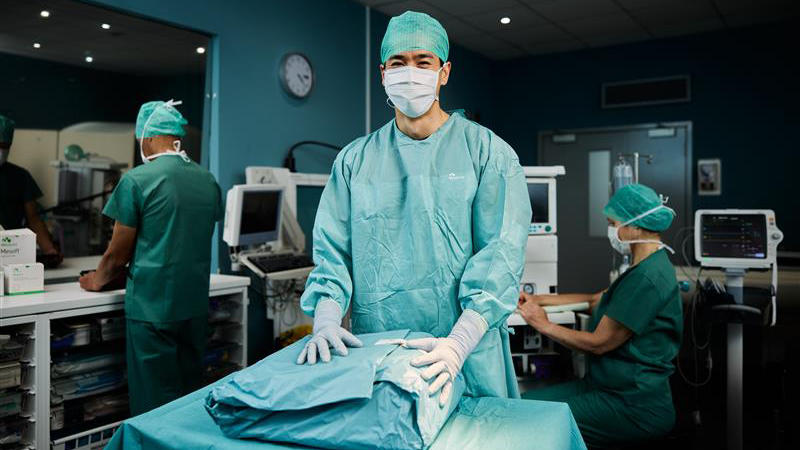
Designing for circularity important for climate-smart healthcare
Healthcare systems around the globe face multiple challenges and reducing greenhouse gases (GHG) emissions is one of them. Today, healthcare's climate footprint corresponds to roughly 4 percent of the global net GHG emissions. Within MedTech, purchased products and services account for a large part of the total carbon dioxide emissions. Circular design plays a key role in improving resource efficiency, contributing to achieving environmental goals. “Designing for circularity is about creating products and solutions that maximise the value of resources, while minimising waste. This means that the products are designed to be reused, repaired, recycled and recirculated in a way that supports a circular economy where resources are kept in use for as long as possible,” says Caterina Camerani, VP Sustainability at Mölnlycke. From cradle to grave (to cradle) Mölnlycke is active in the transition towards a circular economy and sustainability is a strategic priority for us. We lead the way when it comes to manufacturing products in renewable materials in certain product categories. Some of our solutions are certified according to the International Sustainability and Carbon Certification System (ISCC) (see here for the exact list of solutions). Caterina stresses the importance of the sustainability aspects being present in all parts of the value chain, with a holistic cradle-to-grave perspective. “Rather than being a stand-alone pillar, sustainability should be integrated at all levels. We contribute to reducing GHG emissions not only by improving our existing products, but also by, for example, replacing fossil materials with renewable alternatives during the manufacturing process and looking at all stages in the product's life cycle,” she says. As of December 2024, Mölnlycke secured 100 percent renewable electricity for all existing factories and the headquarters in Gothenburg, Sweden (see here for details). We will continue to source renewable electricity through 2030, as pledged in one of the near-term targets validated by Science Based Targets initiative. “We are also downgauging our product packaging to reduce waste and optimise resource use. When we establish a new factory, we carry out careful analyses to identify environmental and social hotspots, which allows us to minimise our impact on both the environment and people from the start,” says Caterina. Waste management important for a closed loop Waste management is crucial to creating a closed loop. Even when packaging is designed with lower weight and use renewable materials, it is not certain that they will be handled correctly after use. Mölnlycke’s view is that this requires healthcare professionals to have the right knowledge. It also requires initiating collaborations with waste management partners. There is a lot to be gained from this type of cross-sector partnerships. A frictionless flow generates higher value for patients and healthcare professionals. This means, among other things, that the focus in the OR can be on patients and clinical outcomes instead of administrative or logistical tasks. Post-operative waste management is one of these tasks. Mölnlycke strives to identify the non-value adding tasks in the OR and to contribute to optimising the flow so that more time is spent on tasks that matter for clinical outcomes (access our Non-Value Report 2025 here). To help customers monitor GHG emissions and track sustainability targets, Mölnlycke has developed a CO2 calculator tool that calculates the environmental impact of our products, making it easier for healthcare providers to take informed decisions. In the tool customers can compare how much GHG emissions are reduced by using solutions containing renewable raw materials in comparison to solutions in Mölnlycke’s assortment that has not yet incorporated renewable materials. Digital product passport “All information in the calculator is based on facts,” emphasises Caterina Camerani, also mentioning the growing need to offer healthcare providers holistic transparent product information, for example through digital product passports. “Through such product passports customers could easily scan a QR code to obtain all the necessary information about, for example, recycling potential and environmental impact of a given product. Mölnlycke strives to drive innovation that creates sustainable solutions in healthcare. And the vision is clear – we want to revolutionise healthcare for people and planet.” To access the original article by Mathias Pernheim in Swedish click here.
-
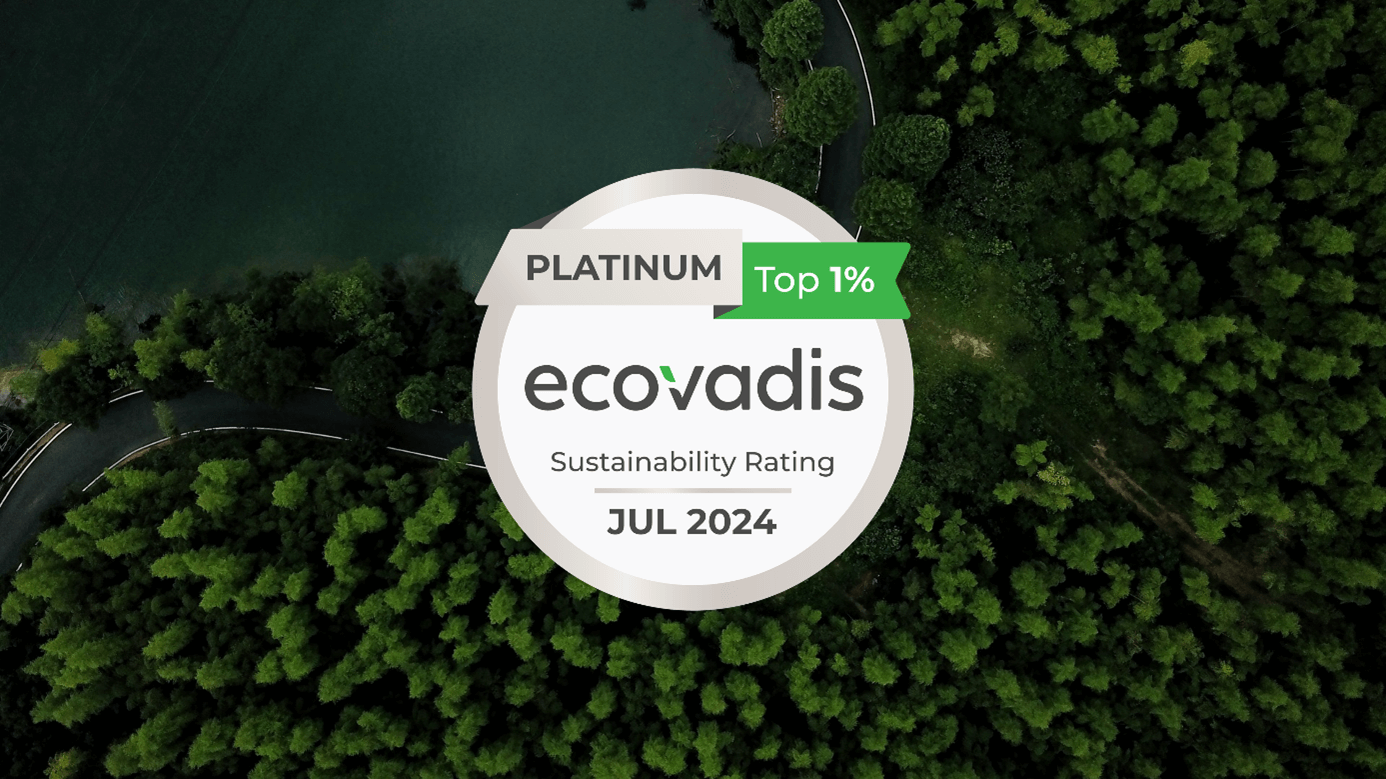
Mölnlycke awarded a Platinum medal from EcoVadis in 2024
Mölnlycke has been awarded the platinum medal in Ecovadis Sustainability Rating, which places us in the top 1 percent of all companies assessed. EcoVadis is a globally trusted provider of business sustainability ratings with a network of more than 130,000 rated companies. Their rating recognises Mölnlycke’s strengths in environmental impact management, labour & human rights interactions, ethical governance and sustainable supply chain partnerships. Mölnlycke have been utilising feedback from EcoVadis, business partners and customers to drive continual improvement in sustainability each year. The acknowledgement of Mölnlycke’s achievments in these areas motivates us to be bolder and go further, driving positive change both for people and planet.
-

July, the peak of the grill season, and grill-related burn injuries!
How to stay safe and avoid burns Make sure your grill is in a safe location. The grill should be placed well away from the home, deck railings and out from under eaves and overhanging branches. Only grill outside. Keep children and pets away. Keep children and pets at least one meter away from the grill area. Keep your grill clean. Keep your grill clean by removing grease or fat buildup from the grills and in trays below the grill. Let it cool completely. When you are finished grilling, let the coals cool completely before disposing of them in a metal container.
-

EUR bond issue and tender announcement
Mölnlycke intends to issue a new 10-year EUR bond under its Euro Medium Term Note (EMTN) programme. The bond will be listed on the Euro MTF market of the Luxembourg Stock Exchange. At the same time Mölnlycke invites its holders of the outstanding EUR 500m bond due February 2025 note to tender any and all of their notes for purchase by the company. Read the full announcement here.
-

In 2023 Mölnlycke was awarded a gold medal for Sustainability by EcoVadis
The benchmarking procedure Mölnlycke are in the second year of working with EcoVadis as an independent and credible organisation to benchmark strengths and improvement opportunities. The rating process required extensive amounts of data and documentation, and therefore teamwork between global sustainability, legal and compliance, information technology, procurement excellence, and people experience teams. Our submission was assessed over a four week period. As a continuation from the previous assessment, results and feedback will be used to prioritise improvement plans. The result A gold medal is awarded to the all top 5%, and our score puts us into the top 3% of all organisations from all industries worldwide. Particularly recognized during the submission were Mölnlycke's commitment to Science Based Targets and measurable improvements in emissions, the strength of Mölnlycke procedures relating to human rights, demonstrable progress in gender equality, and the availability of the Ethics Hotline to all Mölnlycke's stakeholders The results certificate is available to download for verification below, EcoVadis will also provide a detailed validated scorecard to users of their platform.
-

Mölnlycke announces new partnership with burn survivors organisation Phoenix Society
Since 1977, Phoenix Society has served burn survivors, their loved ones, burn care professionals, researchers and others committed to empowering the burn community to enable transformational healing. With the overarching vision of uniting the voice of the burn community globally to “advance lifelong healing, optimal recovery, and burn prevention”, the Phoenix Society offers programmes, tools, education and events to bring this vision to life. With our wide range of burn care solutions including for example cleansing, gentle wound dressings and scar management, Mölnlycke is uniquely positioned to support Phoenix Society initiatives. Our advanced wound care dressings are enabled by Safetac® technology, a gentle silicone adhesive that reduces pain and minimises skin trauma of burn survivors at dressing change. Mölnlycke also provide information about burn dressings and healing through educational content, clinical evidence, and tips and tricks on how to apply burn care. Inline quote: Anders Andersson The power of partnership The partnership between Phoenix Society and Mölnlycke brings together two organisations driven by a mission to make survivors’ healing easier and their lives fuller by reaching survivors earlier, minimising the impact of burns and giving survivors the solutions, resources and community needed to facilitate recovery and support.
-

Mölnlycke integrated Annual Report 2023
Performance highlights Mölnlycke reported strong growth in 2023, with net sales reaching EUR 1,924 million, an 8% increase in constant currency rates. The EBITDA grew by 14% to EUR 545 million, reflecting substantial organic growth and market share gains across most markets. Sustainability achievements We made significant strides in operationalising our sustainability roadmap 2030. Mölnlycke’s near-term greenhouse gas emission reduction targets were validated by the Science Based Targets initiative. Noteworthy progress was made in our journey towards 100% fossil-free electricity by the end of 2024, with 61% fossil-free electricity share in 2023. We also achieved a 20% reduction in overall absolute greenhouse gas emissions across the entire value chain compared to the 2021 baseline. Finally, we expanded the scope of Life Cycle Assessment to cover 30% of our portfolio in terms of net sales. Zlatko annual report news quote Innovation and quality highlights To enhance surgical performance, Mölnlycke introduced hand scanning technology using artificial intelligence and machine learning for optimal glove fit, launched Mepilex® Up in the US, upgraded the Mepilex® Border Post-Op product family globally and registered Hibiwash®, - the new colour- and fragrance-free Hibi formula. We also successfully completed the transition to Medical Device Regulation (MDR), one of the first MedTech companies to do so. Strategic investments Mölnlycke secured long-term financing through a EUR 400 million Eurobond and a EUR 350 million Revolving Credit Facility. We also decided to invest EUR 60 million to increase production capacity, including a new Mepilex Border Flex production line and a new Ethylene Oxide sterilisation unit in Finland.
Knowledge
See all articles-
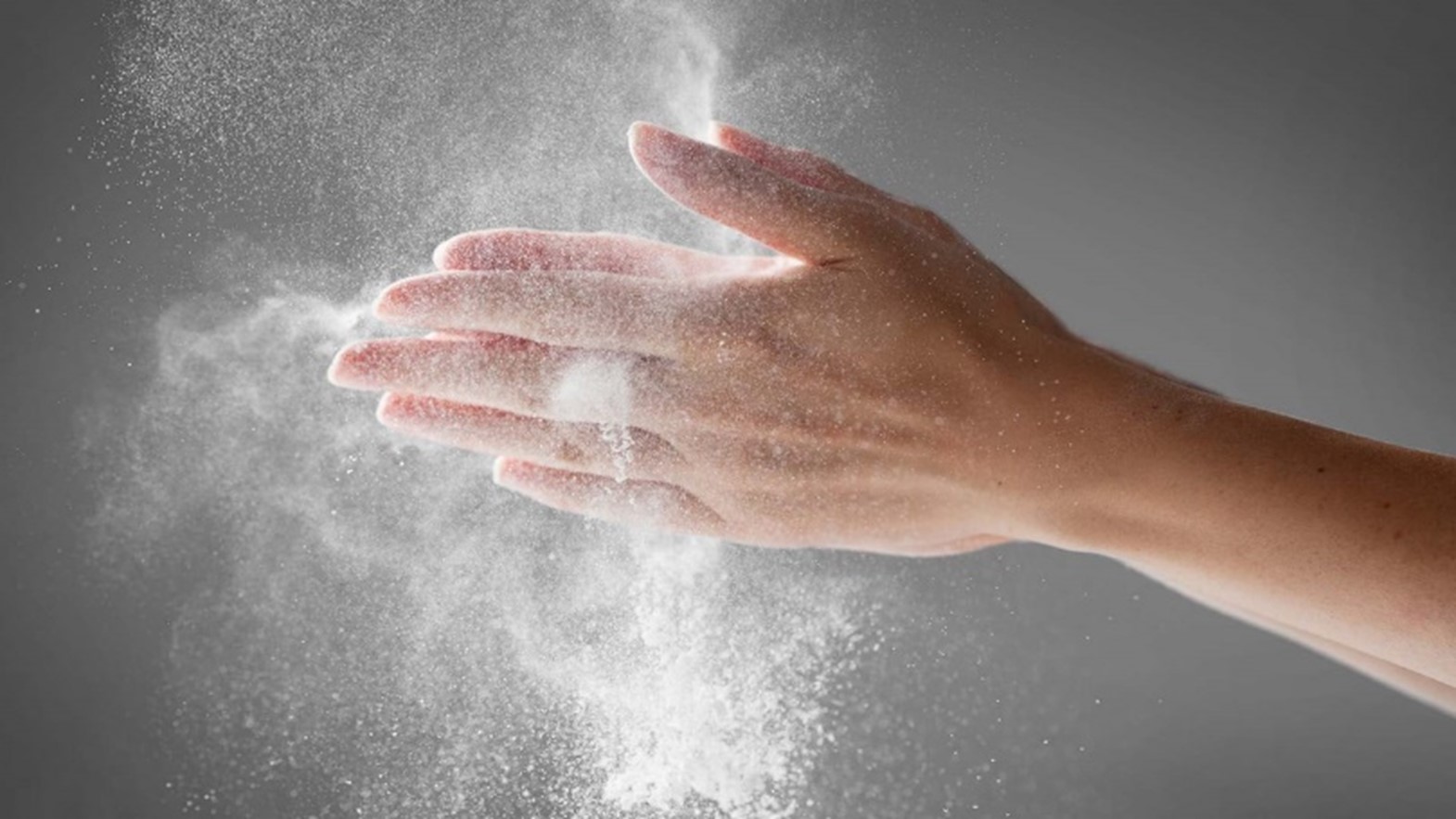
Gloves | 2 min read The dangers of powder in surgical gloves
Surgical glove powder can cause the following adverse health effects: Increased risk of surgical site infections (SSIs) Glove powder can trigger reduced resistance to infection, bacterial environmental contamination, foreign body reaction, delayed wound healing, adhesion formation and granuloma formation 1 2. All of these potential consequences can increase the risk of surgical site infection (SSI) 3. Latex allergy and occupational asthma Powdered latex gloves have been implicated as the largest single contributor to the latex aeroallergen levels in a healthcare facility 4 5. Latex proteins can be aerosolized by attaching to glove powder. This not only increases the risk of acquiring a latex allergy, but can also increase the risk of acquiring occupational asthma 6 . Glove powder increases latex allergy sensitization, potentially eliciting delayed hypersensitivity reactions. Powdered surgical gloves show higher levels of natural rubber latex allergens than gloves that are powder-free. This allows for the potential increase in latex sensitization and/or Type I reactions upon direct and indirect contact 7 8 9 10 11 Biogel surgical gloves: powder-free since 1984 Every single Biogel® surgical glove is powder-free, and has been for over 40 years. Biogel sold the world's first powder-free surgical glove in 1984, and over 40 years later, Biogel is still the only major surgical glove brand with an exclusively powder-free range.
-
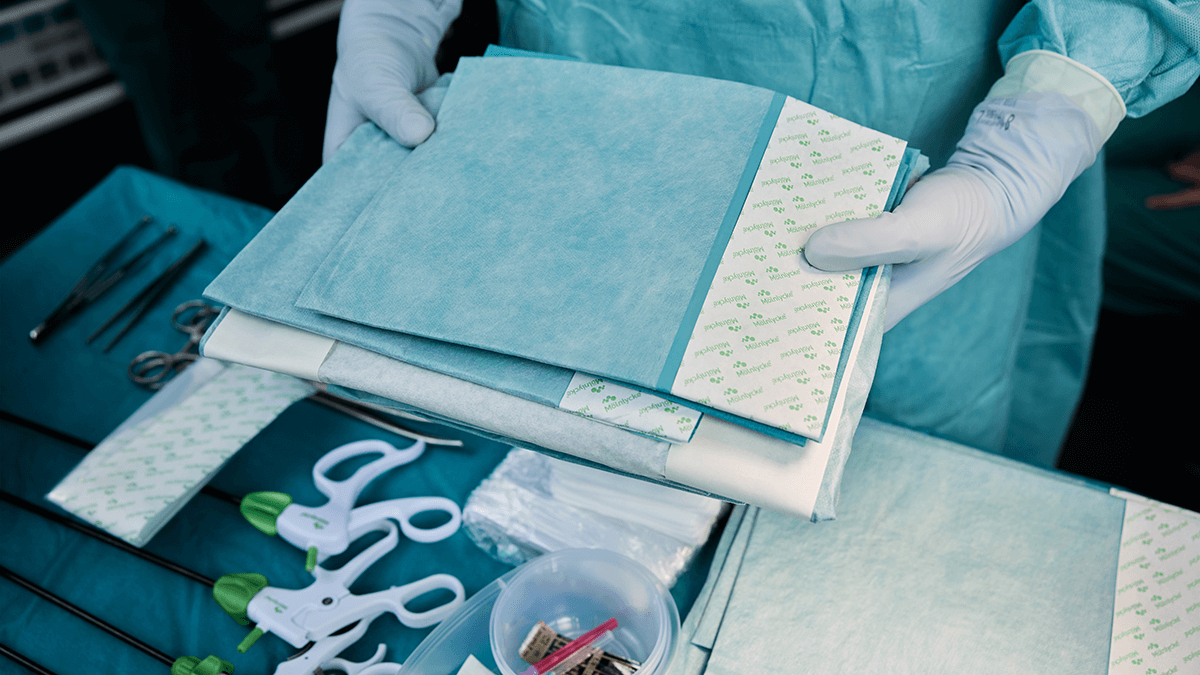
Surgical | 4 min read One hospital achieves 37% more OR procedures using ProcedurePak®
As time management in healthcare, particularly in the surgical field, becomes more important, hospitals are actively looking for more efficiency from fewer resources. One hospital in France achieved significant improvements to operating room efficiency, according to a Mölnlycke ProcedurePak efficiency study. By implementing surgical procedure trays, European hospitals achieved 40-55% time savings in the operating room, making it possible to carry out more surgical procedures – around 37% more procedures in one hospital in France. [Video section] France Cathérine Laurent, OR nurse, Hôpital Privé des Peupliers, Groupe Générale de Santé, Paris, France Exploring how to improve operating room efficiency Hospitals in Europe are traditionally supplied with single-packed sterile products for surgical procedures. For each procedure, the nurses in the operating room need to source surgical instruments in the operating room and collect required materials from the storeroom unit by unit and set it all up for each procedure. Other necessary steps to get the right material in place include stock-taking and ordering, as well as warehousing and transportation. Hospital management today is striving for the most efficient treatment procedures without compromising on quality or safety. Thus there is increasing pressure to handle more interventions while relying on unchanged resources1, 2. Optimising internal processes to improve efficiency has become more and more important, and more effective operating room inventory management, down to the procedure level, has been identified as a way to achieve greater efficiency in the operating room. Study aim: Quantifying time savings from procedure trays The aim of the study was to investigate the effects of and quantify time savings when implementing ProcedurePak trays. Method This was an open prospective study performed as case studies in different hospitals located in Germany, France and Sweden. A total of 26 different ProcedurePak trays were used. For each of the hospitals the single-use material process was studied, from ordering of materials to disposal. This process typically consists of 6 main processes: internal order and delivery, receiving of goods in the surgical department, preparation and clean-up of surgery, external order, receiving of goods via the purchasing department and invoicing. The steps can be broken down into sub-processes and activities. For example, the main process – preparation and clean-up – can be broken down into 14 sub-processes or 33 activities. Each step in the process was described and measured both before and after implementation of the Mölnlycke ProcedurePak trays. For every step of the process, the time and cost drivers were identified by studying practical use and measuring time. Total annual time-saving after implementation of ProcedurePak trays in Germany. Results: Across hospitals, 40-59% time savings achieved The results of the study show that following the introduction of ProcedurePak trays, time-savings in the single-use material process were between 40% and 59% in the hospitals studied. The magnitude of the time-savings depends on several factors, including the number of different ProcedurePak trays used, number of components in each tray and the number of procedures performed with trays. The largest time savings were found in the preparation and clean-up of surgery, which is a key metric for operating room waste management initiatives. But time savings were also shown in other process steps. The time savings were used in different ways depending on individual objectives of the hospital, for example: Performance of additional surgical procedures, giving patients more timely treatment and maximising use of OR resources In the French hospital 37% more surgical procedures were performed following implementation. In the German hospital the number of interventions increased by 18% per year. Training of staff. Conclusions The case studies show that significant time-savings (40-59%) can be gained through implementing Mölnlycke customised procedure trays for surgical procedures in the operating room. The freed-up time makes it possible to perform additional surgical procedures. The financial effect of this is an area for further research. [Download] France case
-
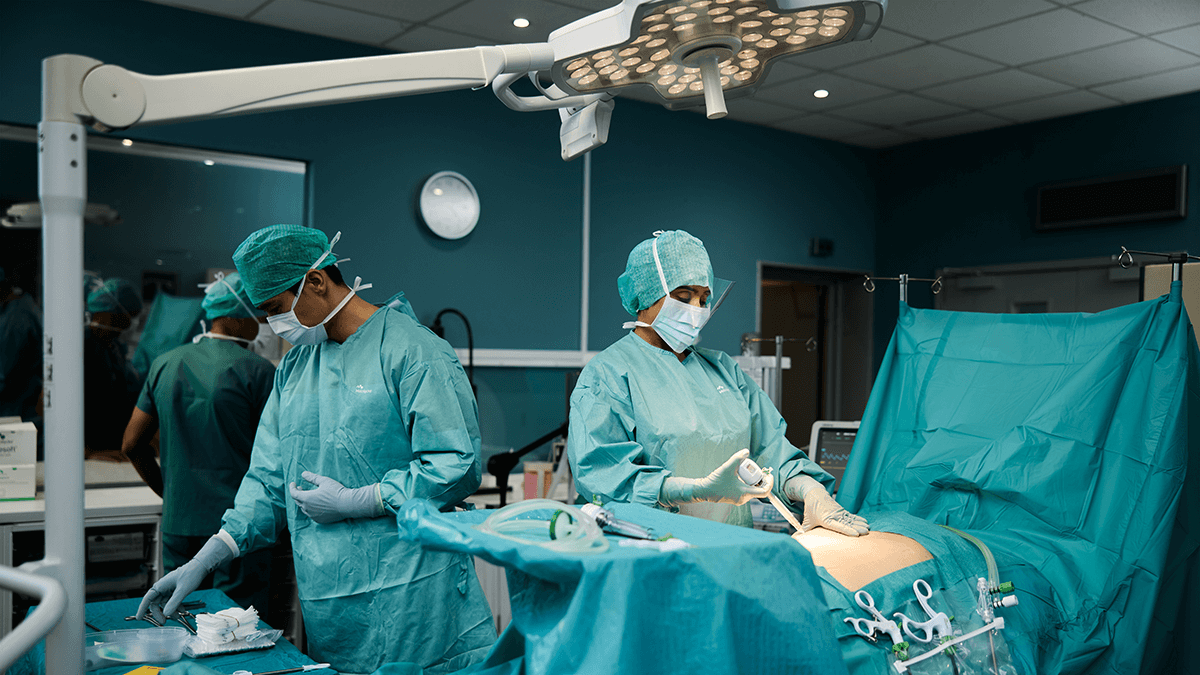
Surgical | 2 min read All-in-one speciality drapes offer many benefits
Speciality drapes for surgery not only offer the infection control measures required in an operating room with their single-use nature but also meet the specific needs of particular surgical interventions. And with consideration for OR efficiency, surgical drape packs can add greater efficiency and time savings. Speciality surgical drapes for OR safety and efficiency Mölnlycke offer a comprehensive range of speciality drapes. The operating room is home to all different types of drapes, including universal sets, but intervention-specific all-in-one drapes have relevant features integrated in the drape for easy and efficient draping. Integrated pouches and tube holders to create an organised working field. Speciality drapes designed specifically for a given procedure, such as a knee operation or orthopaedic operation, offer coverage and protection where it is most needed, thereby reducing the risk of contamination. With fewer parts to handle, fewer steps to take and a shorter, more efficient set-up time, the patient is draped and ready for the procedure to begin faster. This contributes to OR safety and efficiency by: Making setup faster and more efficient, cutting down on prep and overall time in OR Single-use or disposable surgical drapes support aseptic practice Enabling more procedure-specific patient safety and ease of use for OR personnel Speciality drapes are designed to be optimally folded – the folding allows for aseptic application, easy for one person to drape. Allow for easy and efficient draping by one person For saving time – 3 times faster than draping with a universal drape solution¹ Fewer parts, fewer steps – for reducing the risk of contamination²
-
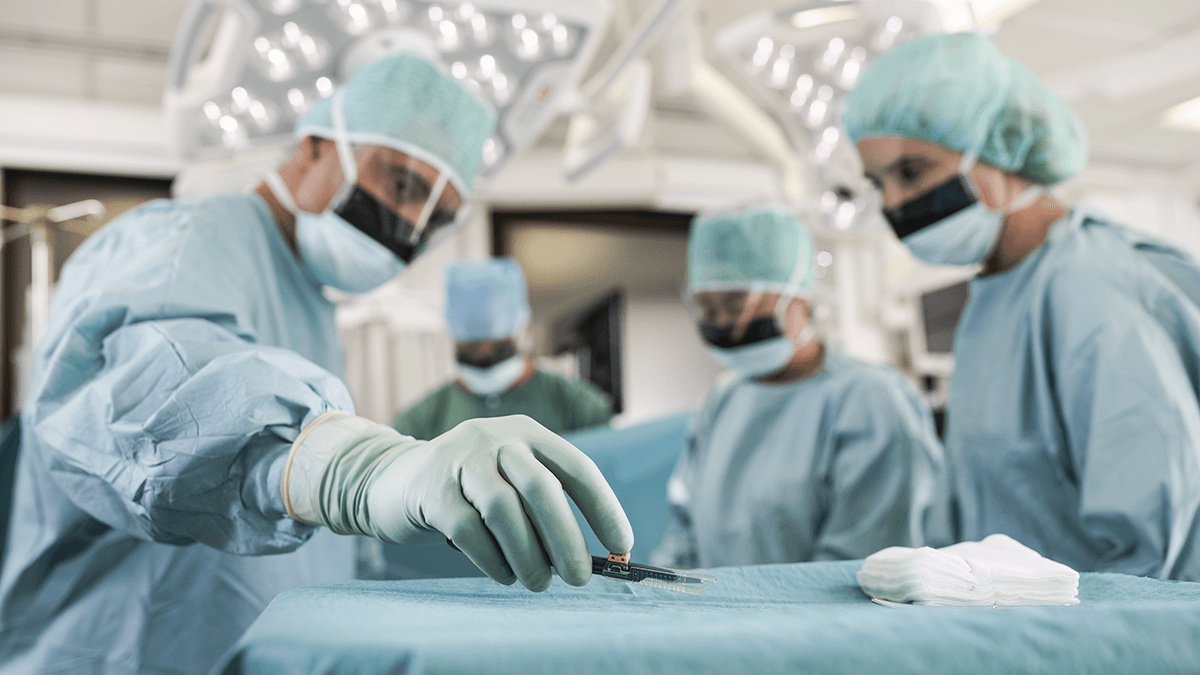
Surgical | 3 min read Calculate your CO2 to plot your sustainability journey
The last thing on your surgical team’s mind when hard at work in the OR is probably how much waste you are generating from single-use surgical instruments and drapes, or how much more efficiency you could gain from customised procedure-specific surgical trays. But as sustainability becomes a watchword for every industry, the single-use nature of antiseptic surgical environments is also coming under scrutiny. While patient safety leads as the most important consideration, hospitals continue to be beset by resource limitations balanced against new regulations that demand that they begin to operate more sustainably. Add to this equation the difficult-to-calculate environmental aspects of the operating room: from the CO2 expended in sourcing and producing the materials used in the production of OR goods to calculating the logistics of getting surgical trays and drapes and other surgical equipment into the hospital and properly distributed. But what if you could make your impact less opaque and gain clarity on exactly what impact the CO2 from your surgical business generates? Sustainable innovation Mölnlycke continuously innovates to offer the most sustainable solutions without compromising on the safety and quality of its products. By applying lifecycle thinking to existing products, the company proactively steers its product portfolios towards improved sustainability outcomes. An example includes a number of ISCC (International Sustainability and Carbon Certification) accredited sets of universal drapes offered by Mölnlycke. One of the three layers that make up the drapes is made of ISCC-certified renewable, biobased raw materials. As a result, an externally reviewed Life Cycle Assessment¹ showed these drapes to generate on average 20% less greenhouse gas emissions than traditional products. Guiding the conversion to sustainability Creating products that fulfil sustainability goals is one dimension of the issue. Another is ensuring that customers are aware of their existence and know the difference, providing clear guidance on a path toward conversion to more sustainable solutions. One such solution is a digital CO2 measurement tool that calculates the environmental benefits of choosing an ISCC drape over our standard product. Mölnlycke currently offers approximately 20 ISCC-certified drapes, consisting of up to 30% biobased material and a range of ISCC-certified surgical gowns. Demand for products using renewable, bio-based raw materials is particularly high in Scandinavia, the UK and Benelux, and is increasing in other markets as well. The calculator’s model includes the product’s entire life cycle, including Scope 1, 2 and 3.
-
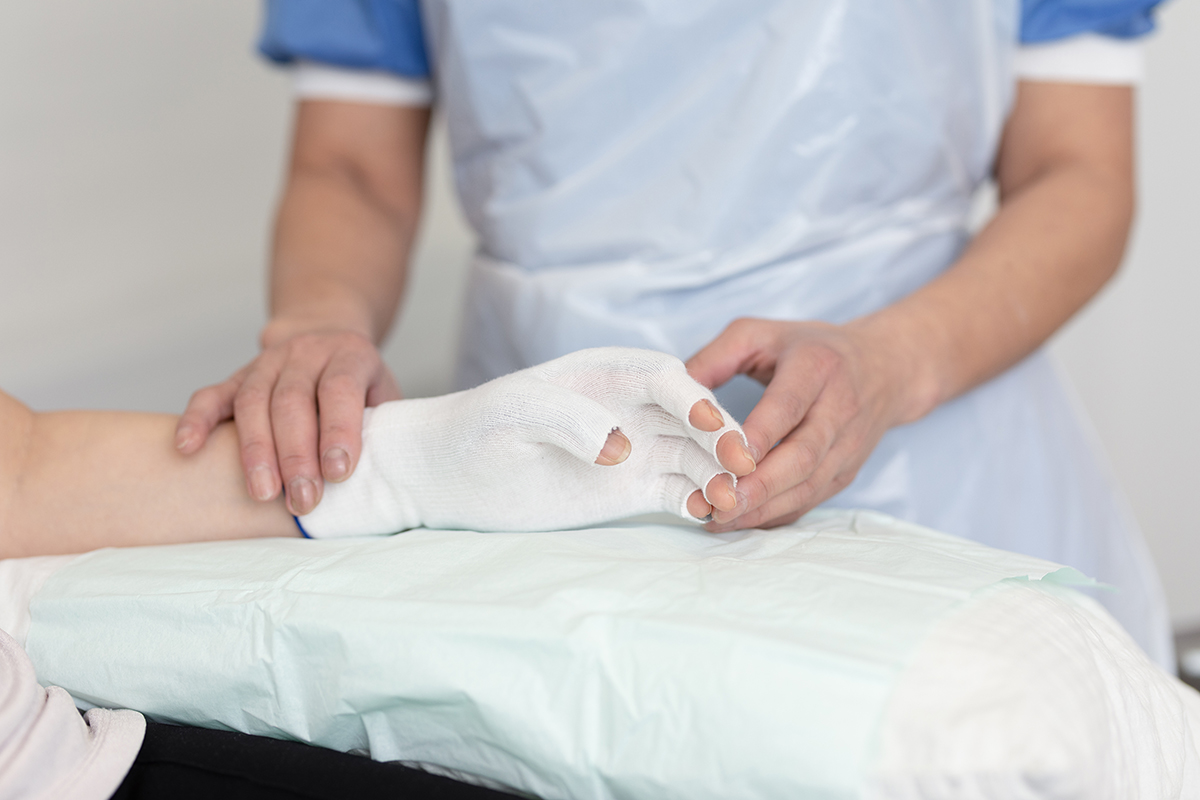
Wound care | 2 min read Prevention and first-aid measures for burns
At Mölnlycke, we work to raise awareness and lower the impact of burns. You can be a part of this movement by learning more about how to act when a burn occurs and how to avoid burns in the first place. Focus on the first-aid measures Adequate first-aid measures help to limit the pain and damage to the skin2 due to burns. Stop the burning process: Remove the burn source and move the person to a safe space Remove all burnt clothing and jewellery if it will cause constriction Cool the burn with cool or lukewarm running water for 20 minutes as early as possible after the injury, within 3 hours. Never use ice, iced water, or any creams or greasy substances like butter Cover the burn loosely with a non-adherent simple dressing or cling film Keep the person warm: Wrap the body in a clean dry blanket Seek medical advice [Download] burns infographic Burns are preventable Burns can happen to anyone, anywhere at any time. It’s important to note that burns are preventable, though, and some simple measures can be taken to prevent burns and scalds from happening: Lower the temperature in hot water taps Keep hot drinks away from table/counter edges, out of reach of young children Establish a 'kid-free zone' of at least 1 meter around the stove and areas where hot food or drink is prepared and carried Use a kettle with a short cord to stop it hanging over the edge of the work surface, where it could be grabbed Do not drink hot liquids through a straw Turn the handles of pans inward More safety tips to prevent burns can be found on the burns prevention poster: [Download] burns poster
-
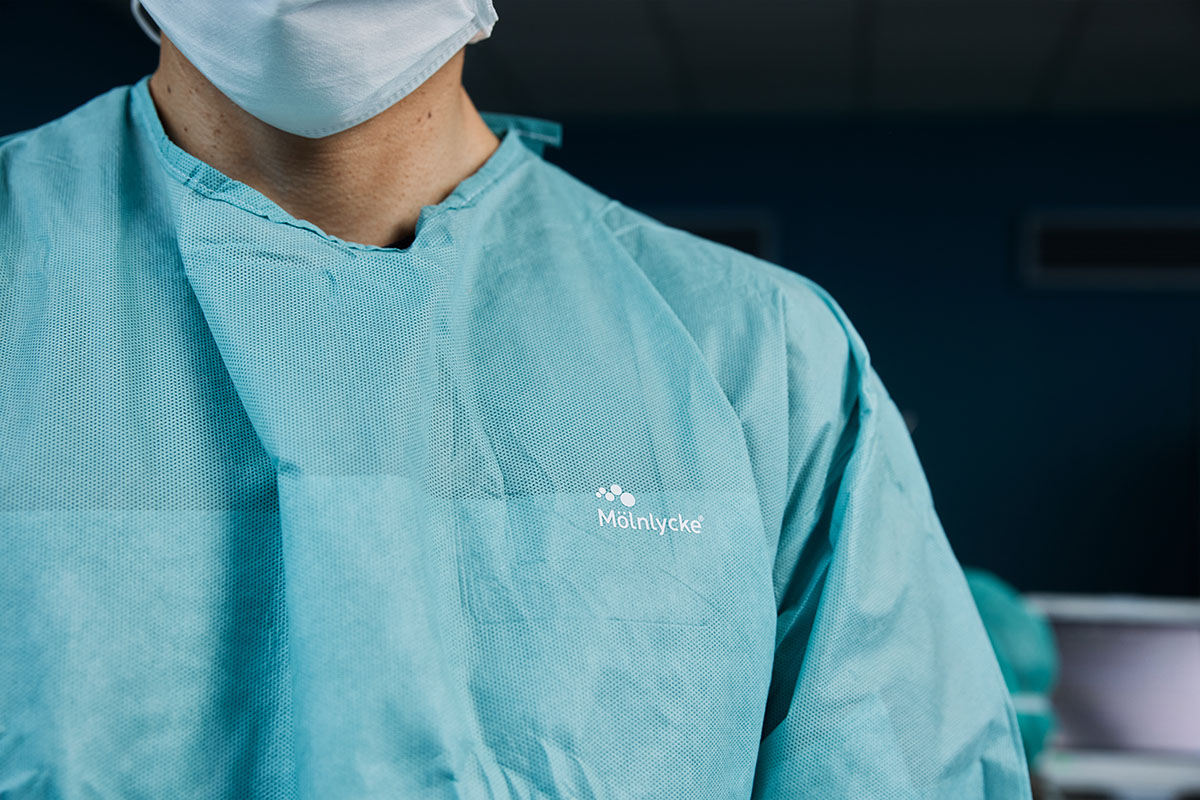
Surgical | 5 min read Surgical gown material guide
Surgical gown materials for optimal protection Personal protective equipment (PPE) worn by healthcare professionals during surgery creates a crucial barrier between the sterile surgical field and the external environment. The design and material composition of surgical gowns enable this barrier. The material must meet performance requirements set by regulatory bodies as well as meet comfort and mobility standards that allow surgical teams to perform easily and without hindrance. Surgical gown material choice influences how impermeable to fluid it is and how effective it is in preventing microbial ingress, maintaining sterility and supporting HCP comfort and wearability. Underlying material selection is a number of different factors, including different properties, manufacturing processes and standards. For example, what kinds of properties does a surgical gown need to have to fulfil its purpose at a given level? Surgical gown material properties Surgical gown material must have a high level of impermeability to prevent the passage of bacteria and viruses. Barrier protection against microorganisms, bloodborne pathogens and other infectious agents is assumed for all surgical gowns, but certain procedures require more rigorous protection than others. Surgical gown material must also possess durability. Surgical gowns undergo rigorous use during the course of an operation and need to retain their protective properties throughout the procedure to ensure safety and reduce the risk of tears or breaches in the material. Breathability and comfort are also considerations in selecting surgical gown material. It needs to maintain a barrier against external contaminants but still needs to allow for adequate airflow for the wearer’s comfort. Reducing moisture buildup and heat retention is key to keep the OR staff comfortable while performing their tasks, especially during long procedures. Surgical gown regulations and guidelines and compliance Different standards and regulations govern the medical devices, including surgical gowns and the material they are made of, in order to oversee their safety and efficacy. Standards bodies, such as the American National Standards Institute (ANSI) and the International Organization for Standardization (ISO) develop industry standards that define the requirements for surgical gown materials. These standards specify criteria such as the properties listed above, such as barrier performance, as well as standards for flammability and biocompatibility to ensure the quality and safety of the products. Manufacturers are also required to demonstrate compliance with these regulations and standards through testing and certification processes. Surgical gown material platforms Material platforms: Polypropylene SMS Polypropylene SMS SMS stands for Spunbond/Meltblown/Spunbond. It is a synthetic material made from polypropylene. Structure: • Spunbond, located outside of the fabric, provides strength to the product. • Meltblown, on the inside of the fabric, provides the repellency to the product. The layers are bonded together with point bonds or heat (small dots, oval or diamond) that hold all the fibres together. BARRIER® surgical gowns made of SMS: • Primary - Comfortable and ergonomic, suitable for dry procedures • Primary Plus - Comfortable multi-purpose surgical gown • Primary Plus –More sustainable, ISCC certified version of Primary Plus • Ultimate - Increased repellency for advanced protection Material platforms: Spunlace BARRIER surgical gowns made of spunlace Spunlace is a soft textile-like material made from pulp/polyester nonwoven fibers. It is produced with more than 50% bio-based material. Structure: • The spunlace fabric is a tissue layer on the outside of the gown, which provides increased comfort. • Polyester fibres on the inside of the gown provide strength. The fibres are embedded into the tissue with water jets. Because the tissue is naturally absorbent, the fabric is always treated with fluorochemical to make it blood repellent. BARRIER® surgical gowns made of spunlace: • Classic - Extra comfort, suitable for most procedures • Classic Urology - Extra comfort, impermeable to fluid BARRIER Classic gowns are made with FSC™ certified paper. By choosing this surgical gown, you are supporting responsible management of the world’s forests. Forest Stewardship Council™ (FSC™), FSC license code: N003452. Learn more: www.fsc.org. Material platforms: Laminate Laminates consist of different layers of material with different properties. Two different laminates are used for the FFP and the VPP gown. Structure FPP: • The FPP laminate consists of a microporous polyethelene film on the outside of the gown and a nonwoven material on the inside of the gown. The microporous film make the gown breathable, and the nonwoven layer provides comfort for the wearer. Structure VPP: • The VPP laminate consists of 3 layers that together make the material resistant to virus. The inside and outside of the gown is made from nonwoven material. The middle layer is a microporous polyethylene film that allows air and moisture to move from the body to the outside of the gown. [Rich text column collection] gowns
-

Wound care | 1 min read Management of pressure ulcers
All routine pressure ulcer preventative actions must be continued in addition to the treatment requirements of the wound. These include; offloading, appropriate surfaces based on risk assessment, repositioning, moisture management and nutritional assessment. Particular relevance are other anatomical sites that may be prone to pressure injury. The treatment of an existing pressure ulcer is based on the severity of the pressure ulcer (stage) and on the specific characteristics of the wound (infection, exudate, sough and the degree of undermining). Regardless of the severity and characteristics of the pressure ulcer, it is essential that offloading of the wound is maintained and that the wound is protected from pressure, friction and shear forces. Mölnlycke provides solutions that support your team in delivering effective treatment to patients suffering with pressure injuries. All the pressure injury care products and support services are designed to optimise outcomes and improve quality of life for your patients.
-

Wound care | 3 min read Pressure ulcer wound assessment and staging*
Pressure ulcer severity assessment is based on the International NPIAP/EPUAP pressure ulcer classification system and requires the clinician to determine the depth of the injury based on visual inspection of the wound and in the case of a stage 1 injury the presence or absence of non-blanching erythema. It should be noted that in most cases a pressure injury will develop over a bony prominence such as the heel or the sacrum (most common sites for pressure ulcers). Following initial staging of the pressure ulcer the clinician needs to ascertain the history of the wound in terms of how and when it was developed and the patient’s understanding of the wound and its causation. Note should be made of the degree of pain experienced by the patient related to the wound as well as any systemic signs of infection. Staging Category/stage 1 Non-blanchable Erythema. May be painful, firm, soft, warmer or cooler as compared to adjacent tissue. [Rich text column section] skin 2 Category/stage 2 Partial Thickness Skin Loss. Presenting as a shallow open ulcer with a red pink wound bed, without slough. May also present as an intact or open/ruptured serum-filled blister. Category/stage 3 Full Thickness Skin Loss. Subcutaneous fat may be visible but bone, tendon or muscle are not exposed. Slough may be present but does not obscure the depth of tissue loss. May include undermining and tunnelling. Category/stage 4 Full Thickness Tissue Loss. Exposed bone, tendon or muscle. Slough or eschar may bepresent on some parts of the wound bed. Often include undermining and tunnelling. Suspected Deep Tissue Depth unknown. Purple or maroon localised area of discolored intact skin or blood-filled blister due to damage of underlying soft tissue from pressure and/or shear. The area may be preceded by tissue that is painful, firm,mushy, boggy, warmer or cooler as compared to adjacent tissue. Rich text column collection] skin 3 Unstageable Depth unknown. Full thickness tissue loss in which the base of the ulcer is covered by slough (yellow, tan, gray, green or brown) and/or eschar (tan, brown or black) in the wound bed. Assessment for all stages Location - Document anatomical location of PI Tissue Type - Determine the characteristics of wound bed, noting the visible tissue which may include pink epithelisation tissue, red granulation tissue, yellow slough, black necrotic tissue Exudate - Determine the type, amount and nature of wound exudate which may include, serous, serosanguinous, purulent and or viscous fluid Odor - Note the presence of malodour from the wound Wound Edge - Observe for undermining of the wound edges or any tunnelling which may be present Peri wound - Describe the condition of the skin surrounding the wound and observe for maceration and inflammation Infection - Assess for overt signs of wound infection Document findings in individuals medical record (EMR) * National Pressure Ulcer Advisory Panel, European Pressure Ulcer Advisory Panel and Pan Pacific Pressure Injury Alliance. Prevention and Treatment of Pressure Ulcers: Clinical Practice Guideline. Emily Haesler (Ed.). Cambridge Media: Osborne Park, Western Australia; 2014
-

Wound care | 2 min read International Wound Dressing Technology Expert Panel
The challenge In wound treatment/management there is currently no standardised way that dressings are evaluated. Whilst test standards for wound care dressings exist, they are limited and not always clinically relevant. Different dressing performance parameters are considered but are not comprehensive and do not always reflect performance in clinical practice. This can lead to consequences in care and the use of resources – risk of wound deterioration, delayed healing and decreased quality of life, as well as excessive expenditure. Our vision To provide insight into the need and promote a consistent and standardised approach for assessing, selecting and purchasing bordered foam dressings for wound treatment/management. This work should drive holistic and measurable performance parameters to optimise clinical and cost-effectiveness outcomes and enhanced quality of care Our goal We aim to EMPOWER clinicians, policy makers, purchasers, patients and informal caregivers to make better informed, clinically relevant decisions to increase quality of life for people living with wounds and improve clinical and health economic outcomes, based on the best available evidence. [Rich text column section] iWDT